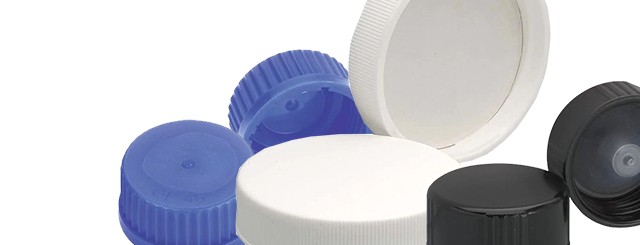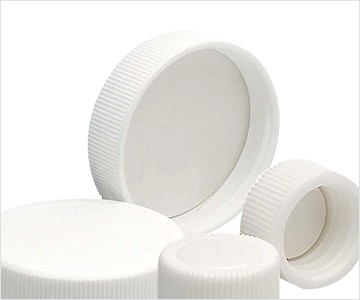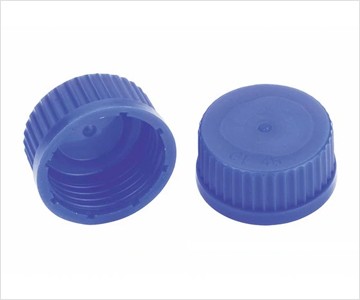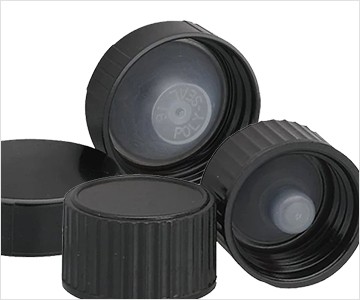How to Choose the Right Bottle Closures

When buying bottles for your lab, consider whether they come with closures or if you will need to buy the caps separately. If the closures are sold separately or if you need a replacement closure for a vessel, there are two main points to consider: size and material.
Threaded or screw-type closures are common for bottles and must fit properly to prevent evaporation, leaks, and spills. The outer and the lining materials must meet your requirements for chemical compatibility, durability, temperature tolerance, and value.
Determine the Size

Screw thread closure sizes are typically expressed as two numbers: the diameter and the standard thread finish. For example, a closure size 28-430 indicates a nominal or rough diameter of 28 millimeters (mm) and a thread finish (430) based on Glass Packaging Institute (GPI) standards.
To find the diameter using a ruler or another measuring device, start at the outermost edge on one side of the bottle opening and measure across the center of the opening to the outermost edge on the other side. Some manufacturers offer special tools for measuring bottle openings. Some manufacturers offer special tools for measuring bottle openings.
The standard thread finish is a combination of the height of the bottle’s neck and the number of “turns” (the number of times the threads pass each other).
- 400: One thread turn
- 410: One-and-a-half thread turns
- 415: Two thread turns and a tall neck
- 425: Two narrow thread turns
- 430: Thick threads and a top bead (“buttress” finish)
Consider the Material Options

Bottle Closure Design and Fit
A number of closure materials are available, most often thermoset (urea, phenolic, or melamine), thermoplastic (typically polypropylene), and metal (aluminum or stainless steel). When selecting materials, consider how you will use the bottles and closures to help you determine which closure materials best suit your needs.
Will the Caps Be Exposed to Chemicals or Solutions?
Thermoset caps offer a wide range of chemical compatibility. Thermoplastic caps resist non-oxidizing acids, bases, fats, and most organic solvents, but cannot be used with strong oxidants. Metal caps are generally corrosion resistant. Aluminum is less resistant to acidic liquids while stainless steel is preferred for food preparation, wine making, and brewing because it does not retain flavors or smells.
How Durable Do the Caps Need to Be?
All three materials have good impact resistance. Thermoplastics are somewhat more pliable, and metals will not fracture with impact.
Can the Closures Be Sterilized?
All three materials are temperature tolerant and can be autoclaved.
Do You Plan to Reuse or Recycle the Closures?
Thermoset material is durable and reusable but cannot be re-melted. Thermoplastics and metals can be reused and recycled.
Similar questions apply to closure liners:

Bottle Closure Filters and Barriers
Will the Liners Be Exposed to Chemicals or Solutions?
Polytetrafluoroethylene (PTFE) liners backed with foam or rubber offer the best chemical resistance and present an inert surface that will not interact with the bottle contents. PTFE forms tight seals and transmits little moisture, and rubber-backed PTFE can be autoclaved. Use PTFE liners for analytical lab samples, high-purity chemicals, strong acids, solvents, environmental samples, pharmaceuticals, and diagnostic reagents.
Vinyl-coated polyethylene (PE) foam has limited chemical resistance and is typically chosen for general-purpose use at temperatures below 120°F. Use this liner for mild acids and alkalis, solvents, alcohols, oils, aqueous substances, and foods and beverages. Do not use with bleaches or active hydrocarbons.
Solid or foam PE liners also seal well, offering good chemical resistance and low moisture transmission. Choose PE for stronger acids and alkalis, non-oil products, nail polish remover, alcohols, aqueous products, cosmetics, and household oils.
PolyCone polypropylene liners are strong and non-reactive. They tolerate heat well and provide a good chemical barrier. These liners are usually partnered with phenolic caps and can be used with oils, soaps, corrosive chemicals, and other liquids.
Rubber liners resist moisture and have relatively low gas transmission rates. Rubber can also meet close dimensional tolerances, are often used for foods, pharmaceuticals (FDA approved), injectables, and culture work, and are autoclavable.
Liners with aluminum or tin foil surfaces can be used with foods, solids and powders, alcohols, hydrocarbons, ketones, organic solvents, chrome cleaners, brake fluids, and oils. Do not use metal-faced liners with strong acids or alkalis.
How Strong and Secure Is the Liner Seal?
Both PE- and PTFE-faced liners form secure seals. Polycone liners form an especially tight seal and resist binding and backing off.
Can the Liner Be Sterilized?
PTFE, polypropylene, and rubber liners can be sterilized. Check with the manufacturer about other liner materials.


